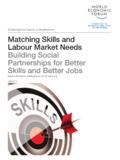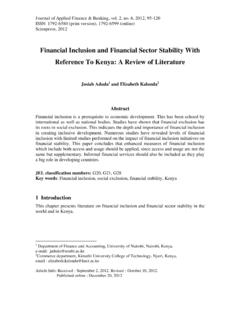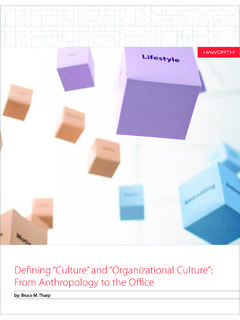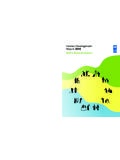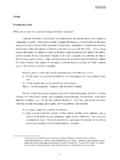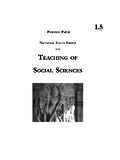Transcription of NORD LB The FUTURE - OECD.org
1 As the 20th century draws to a close,powerful forces of change areconverging that could set the stage fora long, sustained economic boom in the nextfew decades the transition to a knowledge-based society with its potentially hugeproductivity gains; the emergence of moredeeply integrated, global markets for goods,services, capital and technology; and a fast-growing environmental awareness that couldgreatly accelerate the shift to new, lessresource-intensive production and consumptionpatterns. The result could be several decades ofabove-average economic growth, substantialincreases in income and wealth, and significantimprovements in well-being across the what will it take to unleash these dynamicforces?
2 Not only will it will call for a range ofinitiatives to establish the rules and frameworksfor guiding the transition to a sustainable globalknowledge economy. Above all, it will requireexceptional efforts among decision makers ingovernment, business and society at large toencourage continuous innovation, creativity andhigh levels of investment, and to promote boldnew approaches to closer international co-operation and institution building. Inevitablysome countries will benefit more than others, buta long boom with all its wealth creatingcapacity would offer a unique opportunity toreverse the trends of the last decades towardsdeepening inequality and book reviews the forces driving economicand social change in today s world.
3 It asessesthe likelihood of a long boom materialising inthe first decades of the 21st century andexplores the strategic policies essential formaking it reading 21st Century Technologies: Promises and Perilsof a Dynamic FUTURE .(03 1999 02 1 P) FF 140 ISBN 92-64-17029-49:HSTCQE=V\UW^W:The FUTUREof the GlobalEconomyTowards a Long Boom?OECDThe FUTURE of the Global Economy: Towards a Long Boom?BANKGESELLSCHAFTBERLINWestLBNORD/LB NORDDEUTSCHE LANDESBANKGIROZENTRALEOECD99 ORGANISATION FOR ECONOMIC CO-OPERATION AND DEVELOPMENTFile: $1$DIA3:[ ]COPYR 1623E.;7 NGUYENSeq: 1 Page: Free: 4140D Next: 0D VJ: J1:1 9-AUG-99 10:55 OECD, 1999. Software: 1987-1996, Acrobat is a trademark of rights reserved.
4 OECD grants you the right to use one copy of this Program for your personal use reproduction, lending, hiring, transmission or distribution of any data or software is must treat the Program and associated materials and any elements thereof like any other requests should be made to:Head of Publications Service,OECD Publications Service,2, rue Andr e-Pascal, 75775 ParisCedex 16, FUTUREOF THE GLOBAL ECONOMY:Towards a Long Boom?ORGANISATION FOR ECONOMIC CO-OPERATION AND DEVELOPMENTORGANISATION FOR ECONOMIC CO-OPERATIONAND DEVELOPMENTP ursuant to Article1 of the Convention signed in Paris on 14thDecember 1960, andwhich came into force on 30thSeptember 1961, the Organisation for EconomicCo-operation and Development (OECD) shall promote policies designed: to achieve the highest sustainable economic growth and employment and a risingstandard of living in Member countries, while maintaining financial stability, andthus to contribute to the development of the world economy.
5 To contribute to sound economic expansion in Member as well as non-membercountries in the process of economic development; and to contribute to the expansion of world trade on a multilateral, non-discriminatorybasis in accordance with international original Member countries of the OECD are Austria, Belgium, Canada, Denmark,France, Germany, Greece, Iceland, Ireland, Italy, Luxembourg, the Netherlands, Norway,Portugal, Spain, Sweden, Switzerland, Turkey, the United Kingdom and the United following countries became Members subsequently through accession at the dates indi-cated hereafter: Japan (28thApril 1964), Finland (28thJanuary 1969), Australia (7thJune1971), New Zealand (29thMay 1973), Mexico (18thMay 1994), the Czech Republic(21stDecember 1995), Hungary (7thMay 1996), Poland (22ndNovember 1996) and Korea(12thDecember 1996).
6 The Commission of the European Communities takes part in thework of the OECD (Article13 of the OECD Convention).Publi en fran ais sous le titre :L CONOMIE MONDIALE DE DEMAIN:Vers un essor durable? OECD 1999 Permission to reproduce a portion of this work for non-commercial purposes or classroom useshould be obtained through the Centre fran ais d exploitation du droit de copie (CFC), 20, ruedes Grands-Augustins, 75006 Paris, France, Tel.(33-1) 44074770, Fax (33-1) 46346719,for every country except the United States. In the United States permission should be obtainedthrough the Copyright Clearance Center, Customer Service, (508)750-8400, 222 RosewoodDrive, Danvers, MA01923 USA, or CCCO nline: All otherapplications for permission to reproduce or translate all or part of this book should be made toOECD Publications, 2, rue Andr -Pascal, 75775 Paris Cedex16, part of the preparations for EXPO2000 the World Exposition in Hanover,Germany the OECD Forum for the FUTURE is organising a series of four confer-ences to take place beforehand around the theme of People, Nature and Technol-ogy: Sustainable Societies in the 21stCentury.
7 The series will consider four keyareas of human activity: technology, economy, society and government. The con-ferences will explore possible evolutions of key variables and analyse differentdevelopment paths in order to expose some of the main policy implications andoptions. Each conference will provide analysis of underlying trends and policydirections. However, the overall aim of the series is to build a comprehensivefoundation for assessing the critical choices likely to face citizens and decisionmakers in the next entire series benefits from special sponsorship by EXPO2000 and fourGerman banks Bankgesellschaft Berlin, DGBank Deutsche GenossenschaftsbankAG, NordLB/Norddeutsche Landesbank, and Westdeutsche Landesbank Girozen-trale (WestLB).
8 Additional financial support is provided by numerous Asian, Euro-pean and North American partners of the OECD Forum for the was the second conference in the series. It was hosted by the DGBankDeutsche Genossenschaftsbank AG in Frankfurt, Germany, on 2-3 December theme was 21stCentury Economic Dynamics: Anatomy of a Long Boom .After a day and a half of discussion, conference participants concluded thatthe world is on the threshold of a tantalising opportunity the possibility of a sus-tained long boom over the first decades of the next millennium. A confluence offorces particularly the transition to the knowledge society, the emergence of aglobal economy, and the pursuit of environmental stability could come togetherto propel huge improvements in wealth-creating capacity and well-being world-wide.
9 But for this to happen, major advances would have to be made on two policyfronts. First, exceptional efforts would be needed nationally and internationally toencourage continuous innovation and high levels of investment. And second, sub-stantial leaps would be needed in levels of international co-operation on suchmatters as the diffusion of technology and knowledge, market integration andThe FUTURE of the Global Economy: Towards a Long Boom?4environmental transformation. The aim of this conference was to assess the pros-pects for a long boom in the next couple of decades and to explore the policystrategies that could help it become a conference was organised into three sessions.
10 The first looked at thegeneric factors likely to determine whether or not long-run economic dynamismwill continue in the FUTURE . The second addressed specific driving forces likely toaccompany economic dynamism in the next century and potentially spark the highgrowth rates of a long boom over the next twenty to thirty years. Finally, the thirdsession considered the way policy choices are likely to influence the playing out ofdifferent scenarios for a 21stcentury long publication brings together the papers presented at the meeting as wellas an introductory contribution and summary of the main points of the discussionsprepared by the Secretariat. The book is published on the responsibility of theSecretary-General of the of ContentsChapter 1:Anatomy of a Long Boomby Wolfgang Michalski, Riel Miller and Barrie 2:Sources of Continued Long-run Economic Dynamismin the 21stCenturyby Richard G.











